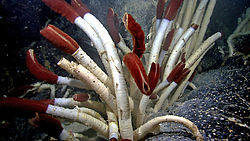Lophotrochozoa
The Lophotrochozoa ("crest-bearing animals") are a group of animals above the level of phylum. It is not part of the usual system of classification. They were recently discovered through molecular phylogeny.[1] They include two of the most successful animal phyla, the Mollusca and Annelida.
| Lophotrochozoa Temporal range: early Cambrian – Recent
| |
|---|---|

| |
| Caribbean reef squid or Sepioteuthis sepioidea is a complex lophotrochozoan. | |
| Scientific classification | |
| Kingdom: | |
| Subkingdom: | |
| (unranked): | |
| Superphylum: | Lophotrochozoa Halanych et al., 1995
|
| Phyla | |
Groups
The Lophotrochozoa comprise two groups, the trochozoans and the Lophophorata. The exact relationships between the different phyla are not entirely certain. However, it seems that neither the lophophorates nor the trochozoa are monophyletic groups by themselves, but are mixed together.[2]
- Trochozoans produce trochophore larvae, which have two bands of cilia around their middle.[2] The Trochozoa include the Nemertea, Mollusca, Sipuncula, Echiura and Annelida.[2]
- The Lophophorata are united by the presence of a lophophore, a fan of ciliated tentacles surrounding the mouth. Some authors considered them deuterostomes, before RNA trees placed them together with the trochozoans. The Lophophorata include the Bryozoa, Phoronida, and Brachiopoda.[2]
Other phyla are included on the basis of molecular data.
Lophotrochozoa Media
References
- ↑ Philippe, Hervé, Nicolas Lartillot1 and Henner Brinkmann. 2005. Multigene Analyses of Bilaterian Animals Corroborate the Monophyly of Ecdysozoa, Lophotrochozoa, and Protostomia. Molecular Biology and Evolution 22(5):1246-1253; .
- ↑ 2.0 2.1 2.2 2.3 Introduction to the Lophotrochozoa - accessed 8 August 2008









